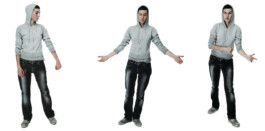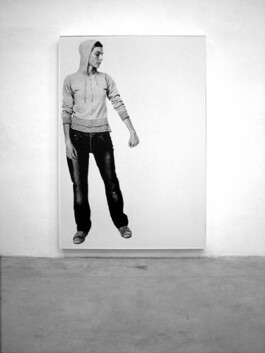LYNNDIE ENGLAND I–III
three c–prints, each 120 x 175 cm, 2005
Die dreiteilige Arbeit LYNNDIE ENGLAND I-III zeigt Gesten von Fotografien, die im Zuge des Folter Skandals im Gefängnis Abu Ghraib 2003 entstanden. Zwei Körperhaltungen der posierenden Soldatin Lynndie England, sowie eines Folteropfers stellte Yvon Chabrowski im Studio nach und passte sie nach einem Prozess der Bildbearbeitung ihrer eigenen Körpergröße an. Die des Kontextes beraubten Gesten stehen auf diese Weise gerahmt und im neutralen Weiß der Interpretation frei.
Zum einen stellt sich der Eindruck ein, es handle sich um werbende Mode-
fotografien, die ihre Bildwelt dem rebellischen Feminismus, etwa der Riot-Grrrl-Bewegung, abgeschaut hat.
Was hat nun der Feminismus mit folternden Soldatinnen zu tun, was mit der Jugendmode? Beleuchtet die Geste aus Abu Ghraib die subkutan militarisierte westliche Alltagskultur? Wie viele Jugendliche aus westlichen Ländern würden in ähnlicher Situation auf ähnliche Weise handeln?
Welche Bilder hatte Lynndie England im Kopf, die sie veranlassten, ihre Posen zu wählen? Was passiert, wenn die symbolische Geste der Kastrationsdrohung, wie sie im militanten Feminismus ironisch auftaucht, im Bagdader Gefängnis an nackten irakischen Männern gespielt wird?
Im dritten Bild zeigt sich die erzwungene Pose des gefolterten Haj Ali Al-Qaisi, die einen Gestus aus christlicher Bildikonographie wiederholt. Trug diese Geste zur Ikonisierung des Bildes in der westlichen Welt bei? Was veranlasste die Folterer diese Pose zu erzwingen? In wie weit spiegelt die Geste der ausgebreiteten Arme eine anthropologische Konstante oder handelt es sich um eine originär christliche Bildsprache?
Die Fotografien hüten sich davor, all diese Fragen zu beantworten: Sie inszenieren einen diskursiven Rahmen. Sie stellen eine Abstraktion her, welche auf die Details der Körpersprache verweist. Diese Reflexion über die Geste wiederum findet durch ihr Zur-Schau-Stellen in einer der Werbefotografie entlehnten Ästhetik statt und wird durch den Titel, der die Herkunft des Ausgangsmaterials benennt, konterkariert.
The piece LYNNDIE ENGLAND I-III depicts gestures from photographs that were taken during the torture-scandal in the prison Abu Ghraib in 2003. In the studio, Yvon Chabrowski re-constructed two body postures and process the images. The first is of a soldier posing and the second is of a torture victim. She adjusted them to the size of her own body and place them on a white background deprived of context and left open for interpretation.
At first, one can have the impression that this is about fashion advertisements because they copied propaganda from rebellious feminist movements like the Riot-Grrrl movement. But what has feminism to do with the torturing of a soldier? Do the gestures from Abu Ghraib reflect the subcutaneous militarized Western everyday culture? Would children from Western countries be treated similarly in similar situations? What kind of images did Lynndie England have in her head that provoked her to choose these poses? What happens when the symbolic gesture of castration, as it ironically appears in militant feminism, is played onto the naked bodies of Iraqi men in a prison in Bagdad?
The third picture depicts a torture victim, Haj Ali Al-Qaisi, in a pose that is reminiscent of Christian iconography. Does this gesture contribute to the iconization of pictures in the Western world? Why did the torturer choose these poses? To which extent does the gesture of widely open arms mirror an anthropological constant or is it rather about an original Christian pictorial language?
The photographs do not answer all these questions but they are staging a discursive frame. They are producing an abstraction that refers to the details of body language. On the other hand, the mimicking of the gesture is possible through the borrowed aesthetics of advertisement photography and at the same time, obstructed by a title that counteracts the origin of the material.
Till Gathmann, Dezember 2006
LYNNDIE ENGLAND I-III, three c-print, each 120 x 175 cm, 2005
at LADEN FÜR NICHTS, KEINER STIRBT with Carsten Tabel



